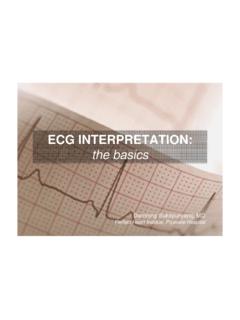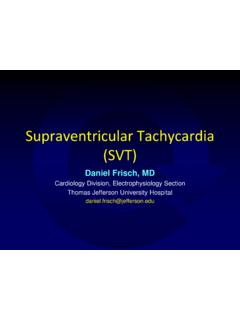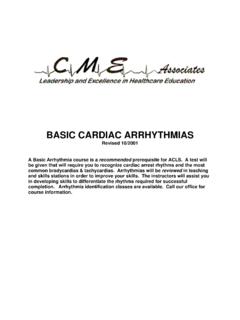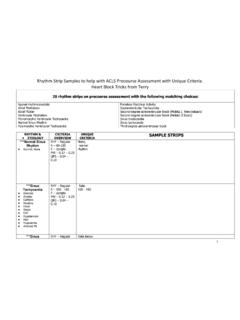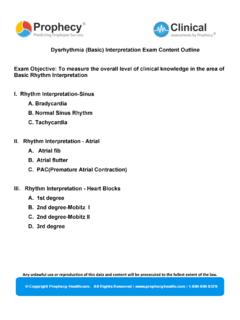Transcription of Use of the human dive reflex for the management of ...
1 Use of the human dive reflex for the managementof supraventricular tachycardia : a review ofthe literatureGavin Smith,1 Amee Morgans,2 David McD Taylor,3 Peter Cameron4 ABSTRACTB ackgroundThe human dive reflex (HDR),a physiological phenomenon similar to the bradycardiareflex used by marine mammals during prolongedsubmersion, can be employed in managing paroxysmalsupraventricular tachycardia (PSVT). This review aims toidentify a standardised HDR technique forhaemodynamically stable PSVT, to determine theeffectiveness of the HDR and to define its usefulness inthe prehospital review of the Medline, EMBASE andCINAHL databases was conducted.
2 Articles wereincluded if they described the use of the HDR to revertPSVT in the prehospital or emergency medical setting,the nature of the effectiveness of the HDR for PSVT orhistorically significant developments of HDR techniquesfor PSVT reversion. Articles not available in English ordescribing the use of HDR in animal studies only articles were identified, of which 21 werefound to be relevant. These included 10 studies of HDReffectiveness in PSVT and three physiological studies ofHDR effect. No standardised model of performanceexists for the HDR. Elements of performance include:a cold stimulus applied to the entire face, a specifictemperature of the cold stimulus, application duration,breath holding during HDR and posture assumed toperform the procedure.
3 There are also safety andlogistics issues with using the HDR in prehospital HDR represents an effective methodof terminating PSVT in the hospital emergencydepartment. Its usefulness in prehospital care requiresfurther evaluation of the elements of the manoeuvre todetermine appropriateness to this dive reflex was originally observed in aquaticanimals, specifically seals. It is a cardiovascularreflex, mediated through increased vagal tone,that results in more efficient oxygen utilisationand a slower heart rate while ensuring adequatecerebral perfusion (through maintenance of meanarterial pressure) and redistribution of core precipitated in humans by immer-sion in cold water, the human dive reflex (HDR)
4 Primarily results in a reflex bradycardia bradycardia, and an associated increase inmyocardial refractoriness, can be harnessed ina simple and non-invasive manoeuvre for thetermination of paroxysmal supraventriculartachycardia (PSVT).The HDR manoeuvre in humans has resultedfromapplying the concept of cold inducedbradycardia (stimulation of thermoregulatorysensors in the skin triggering increased vagal tone)to the reversion of PSVT through prolongedmyocardial have demon-strated that immersion of the face only is sufficientto elicit this reflex in human simplicity of facial immersion to elicit the HDRis useful in providing increased vagal tone for PSVT management .
5 Increases in vagal tone above thatgenerated by the HDR alone have been reportedwhen subjects performing the manoeuvre alsoemployed deep inhalation and breath holding,which provoked a mild isdue to stimulation of baroreceptors in the carotidbodies and aortic arch, which triggers an increase invagal tone (a reflex common to both the Valsalvamanoeuvre and the carotid sinus massagetechniques8e10). It is likely that the combination ofbreath holding and cold stimulus provides the HDRwith an increased effect for PSVT termination;however, this is yet to be quantified in of the HDR for the reversion of haemody-namicallystable PSVT has been advocated sincethe early , use ofthe HDR in the prehospital setting is a relativelyrecent adaptation from emergency medicinepractice, providing a simple management strategyfor patients with regular narrow the HDR has gained acceptance forthetreatment of PSVT within internationalresuscitation guidelines,14e16a standard approachwith maximum effectiveness has not beendescribed.
6 Consequently, this review aims to iden-tify a standardised technique to elicit HDR for themanagement of haemodynamically stable PSVT, todetermine the effectiveness of the HDR for termi-nation of PSVT and to define the suitability of theHDR for prehospital emergency care comprehensive search strategy was developed,incorporating both the peer reviewed and non-peerreviewed literature, and was based on the CochranePrehospital Search Filter was used tosearch the electronic databases Medline (1948 toOctober 2011), EMBASE (1966 to October 2011),CINAHL (1937 to October 2011), the CochraneLibrary of Systematic Reviews and the CochraneDatabase of Abstracts of Reviews of Effects(DARE).
7 In addition, the reference sections of arti-cles identified were scrutinised and relevant of Epidemiologyand Preventative Medicine,Monash University, Prahran,Victoria, Australia2 Ambulance Victoria, Doncaster,Victoria, Australia3 Austin Health Heidelberg,Victoria, Australia4 Department of Epidemiologyand Preventative Medicine,Monash University, Prahran,Victoria, AustraliaCorrespondence toDr G Smith, Department ofEpidemiology and PreventativeMedicine, Monash University,Faculty of Medicine, Nursingand Health Sciences, AlfredCentre, 99 Commercial Road,Melbourne 3004, 27 December 2011 Published Online First3 March 2012 Emerg Med J2012;29:611e616.
8 On July 15, 2012 - Published by from The following key terms were used in the search strategy: divereflex, human dive reflex, diving reflex, paramedic, ambulance,emergency medical technician, emergency medicine, tachyar-rhythmia, supraventricular tachycardia , paroxysmal supraven-tricular tachycardia , atrioventricular nodal re-entrant tachycardiaand atrioventricular re-entrant were included if they discussed use of the HDR torevert PSVT in humans of any age in the prehospital or emer-gency medicine setting. Articles were also included if theydescribed specific attributes or the nature of effectiveness of theHDR on regular narrow complex tachyarrhythmias.
9 Or thehistorical significance of the development of knowledge ofHDR therapies for regular narrow complex were excluded if they were not available in English ordescribed the use of HDR in animal studies total of 211 articles were identified during the search and nonereported investigations undertaken in the prehospital cross referencing to eliminate duplications and sortingthe results according to technique, effectiveness and application,21 articles were selected for further analysis (figure 1). Tenclinical studies were found to be of relevance, as they dealtspecifically with the use of the HDR in the management ofPSVT (table 1).
10 1246891318 Three physiological studies werealso identified which assist in defining responses to the HDR inhealthy single review article provideda description of the elements of the HDR which may bequantified within a standardised model of techniques used to elicit the HDR varied greatly,comprisingfive essential elements:<A cold stimulus applied to the entire face.<A specific temperature of the cold stimulus.<A duration of application.<Breath holding during performance of the HDR.<A posture assumed to perform the single review article suggested a method for optimising theHDRresponse for the management of authorsdescribed the elements of the HDR (as above), and also included emotion as a component of effectiveness.
